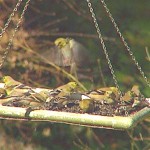 The other day I was taking inventory of items in my tool shed and it looks like it’s time to stock up on birdseed. It is important to take care of our feathered friends through the winter when food sources become scarce.
The other day I was taking inventory of items in my tool shed and it looks like it’s time to stock up on birdseed. It is important to take care of our feathered friends through the winter when food sources become scarce.
I like to set aside one afternoon to take down all of the feeders and really wash them well. I use a cleaning solution of one part vinegar to four parts water. If getting a brush inside the feeder is difficult, I use a handful of rice to serve as an abrasive to clean the interior. Tube feeders can be a challenge because there are so many parts to them, so I just remove whatever I can and then I use a solution of bleach and water to soak all the parts. And if you find soaking alone does not do the trick, you may have to use a little elbow grease and maybe even a toothbrush to get down into some of the tighter spots. For wooden feeders, I avoid using bleach and instead use a mild dish washing detergent and a stiff bristle brush to clean them up. With all types of feeders it is important to rinse them thoroughly and let them dry completely before refilling them.
To attract my favorite birds I found that it helps to learn what type of seed they prefer. For instance, your basic bag of mixed seeds includes millet, cracked corn, small sunflower seeds and milo. Now this will get the attention of jays and doves. But if you’d like to see chickadees and cardinals at your feeder, try putting out black oiled sunflower seeds. If you want to attract finches, nuthatches and siskins offer thistle seed. Now, don’t worry about thistles coming up everywhere, the seeds are generally sterilized. And here’s another idea, suet cakes. It’s a high-energy food made of animal fat and seeds that the woodpeckers just love.
With so many feeders on the market, how do you choose the best one? Well, one of the first considerations is durability, the thing has got to last. It needs to be well built, so it can withstand a fall. And it should be resistant to the weather, rust and squirrels. I also look for one that holds a lot of seed, so I don’t have to refill it so often.
Of course, you want a good-looking feeder, so style is also important. There are as many different types of bird feeders available as there are birds. I always seem to go for ones that blend into the environment. They should also be made with materials, paints and finishes that are non-toxic and bird-friendly.
I like tube feeders for a number of reasons. They don’t waste much seed and you can always tell how much food you have in them. And since they have small perches, it keeps large birds from dominating at feeding time. They are also made with smaller holes for specialty seed like thistles.
When placing my feeders, I like to put them in areas where the birds will feel safe. Close to a large shrub where they can take cover or up in the branches of a tree. And I set up several feeding stations in different areas of my garden to help disperse the bird activity. This prevents overcrowding. Periodically, I like to move my feeders around. This will reduce the concentration of droppings and possible diseases.
If you find a dead or diseased bird around your feeders, one not killed by a predator, you may want to disinfect your feeders weekly. You can do this by simply soaking them for 3 – 4 minutes in a solution of 1 part household bleach to 9 parts water.
Now, there’s another way that you can feed birds that’s particularly attractive to gardeners. Select plants for your garden that are both beautiful and produce fruits and berries that birds love to eat, like crabapples and dogwoods. And when it comes to shrubs, try something like grape hollies or roses for their beautiful bright hips in the winter.
Be sure and place your feeders and plants in places where you can enjoy watching the birds from your window. Nothing brightens a winter day like the beauty of colorful songbirds in your garden.
By P. Allen Smith